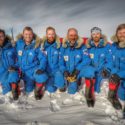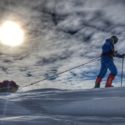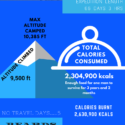Ex DRAGON POLAR PILGRIM (also referred to as SPEAR17, South Pole Expedition Army Reserves 2017) first came into being over two years ago in November 2014. The original plan was for a team of Army Reserves to ski 730 miles from the coastline of Antarctica to the geographic South Pole. This was to be an unsupported and unassisted trip with each man hauling his own pulk (sledge) containing everything he needed to survive out on the ice for up to 50 days. Man-hauling is the purest form of polar travel and doesn’t utilise wind assistance from kites or use resupplies of food. This was deemed a considerable but achievable challenge for a team of well-prepared Army Reserve soldiers.
However, in Jan 2016 a tragic incident took place that changed all this. A great friend of ours, Lt Col Henry Worsley MBE, sadly lost his life while attempting a solo unsupported full traverse of Antarctica. An epic 1,100 mile journey that would have been a polar first, he fell just 110 miles short of reaching his goal. I had the honour of completing an 800 mile trek to the South Pole with Henry back in 2011 and he was a huge inspiration to me. So, after extensive discussions with the team and sponsors it was decided we would use our trip to honour the legacy of Henry. This was achieved by altering our route and we would now attempt a 1,100 mile full coast-to-coast traverse. Henry’s wife Joanna became one of our patrons and she very kindly loaned us Henry’s compass that we used to guide our expedition. The plan now was to complete his route in his memory, a serious undertaking. Previously only 3 expeditions (totalling 6 people, all full time professional explorers) had ever managed a full foot traverse of Antarctica, and it had never been done by a British team. More people have walked on the moon (twelve) than have traversed Antarctica. It was a bold and ambitious undertaking by any standards. After rigorous selection, I had a team of five motivated and fit Reservists, however they were polar novices and some had never been on skis.
After 2 years of intensive planning, preparation, selection and training, our team of six headed to Punta Arenas in southern Chile in late Oct 2016. There we were reunited with our equipment and conducted final preparations. It took us 4 solid days just to prepare our 80 days of freeze dried food per man. Once the pulks were fully packed they weighed in at over 120kg per man, a significant weight to be dragging over 1,100 miles across the most inhospitable environment on the planet. We then focused on enjoying our last bit of civilisation for 3 months and stocked up on steak and fine Chilean red wine while waiting for a weather window to land safely in Antarctica. Finally, in mid November 16 the weather gods were kind and we were flown into Union Glacier and from there to our start point on the coastline of Antarctica at Hercules Inlet. As the six of us watched the ski plane depart the sense of isolation truly kicked in and the enormity of the challenge before us came into sharp focus. One of the biggest challenges for Polar expeditions has always been team dynamics. If we were going to make it, we needed to work seamlessly together.
Our first leg was a 730 mile ski to the South Pole and we needed to crack it in good time to have any chance of completing the full traverse. We pushed hard right from the start and quickly settled into a routine of skiing for 10 hours a day. We would ski in single file and change over the lead man every 70 minutes. Slick routines became essential to making good daily mileage. Breaks were reduced to the minimum – enough to grab a drink and some food, and swap over the lead man before clipping in and setting off again. At the beginning, we experienced temperatures around -20c which we were fairly comfortable with, but as we gained altitude they dropped into the -30c’s. We started at sea level and climbed to 9,300ft by the time we reached the Pole. In the 40 days it took us to get there we only had one no travel day due to one of the guys getting a foot infection and requiring antibiotics. Incredibly we arrived at the South Pole on Christmas Day and having made such good progress were able to rest up there for 2 days before heading out on the next leg. While at the Pole we conducted medical assessments and measured weight loss and it was decided that one of the team members was in a dangerously weak state and would not continue with the expedition. We had all lost on average around 16kg, having been burning around 10,000 calories a day while only consuming 6,500, but the team member who finished at the Pole had lost far more muscle mass than the others.
On the 28 December 16 the remaining 5 of us headed out into the wilderness once more from the relative comfort of the South Pole. This next leg was a 400 mile journey out across the polar plateau and across the infamous Titan Dome, which at 11,000ft is notorious for being particularly desolate, cold and windswept. Temperatures now averaged -45c and katabatic winds hammered us daily. We couldn’t sit out the appalling conditions, knowing they were just as likely to continue and we had to make the pick-up point before the weather closed in for the season. As a result we made hard-won miles each day. We all suffered from frostbite, including one team member whose cracking and bleeding mouth made eating and sleeping a daily hell. At that point, the decision to continue from the comfort and relative civilisation of the South Pole seemed like madness.
After a very challenging 16 days of hard slog we eventually reached the top of the Transantarctic mountains on the far side of the continent. This was the point where Henry had ground to a halt and was a very poignant time for the team. We scaled a nearby mountain peak that had spectacular views back across the plateau and down the Shackleton Glacier and conducted a memorial service. All rounded off with a tot of whisky and one of Henry’s favourite cigars, although lighting it in a howling gale at -53c was a challenge. It was a fitting tribute to a great man who many counted as a friend.
We were then pinned down in the tents for 36 hours in a full-on blizzard before we could begin the final stage of our journey. We had now covered over 1,000 miles in 9 weeks and arrived at the top of the Shackleton Glacier, our gateway to the coastline of Antarctica below. We had hoped that the 90 mile descent would be a straight forward finish to our journey, but how wrong we were. We had very little information as no one had ever descended via this route. The glacier proved to be a jumbled mass of disturbed ice, crevasses and moraine. Skis were swapped for crampons and suddenly the pulks became out of control – accelerating downhill on the slightest gradient to smash into the backs of the legs of the unwary and wipe them out. We were falling into snow-covered hidden crevasses up to 20 times a day and regularly having to send out recces to try and find a route through. Finding campsites on the diamond hard blue ice with sufficient snow to melt for our drinks and food became a real issue. The utmost patience and perseverance was required to navigate this alien-like terrain.
But, in the words of the great Polar explorer, Shackleton, ‘through endurance we conquer’, and after 6 punishing days the somewhat battered and bruised team emerged out of the mouth of the glacier and onto the Ross Ice Shelf. Here we had to select and mark a suitable runway to get the ski plane in for our pick up. Finally, after 68 days out on the ice we spotted the small black dot in the sky that signalled our taxi ride home. It had been epic!
The expedition was a resounding success and we were the first British team to traverse the continent and the first ever to complete our specific route. The expedition generated a huge amount of positive publicity for the British Army across a range of media channels including appearances on Sky News, BBC’s The One Show and BFBS/Forces TV channels and feature stories in national and regional press. It also served as a fitting tribute to the late Lt Col Henry Worsley MBE.
We could not have done this expedition without the incredible support of the Ulysses Trust. They supported us significantly on the main expedition as well as the build-up training trips. The entire team would like to express their gratitude to the Trust for believing in us and assisting us over the last 2 years. It’s been an absolute honour to work with you on this bold and ambitious project and we hope to work with you again in the future. We have nothing but admiration for what you do, to strive, to seek, to find, and not to yield.
WO1 Lou Rudd
Expedition Leader




